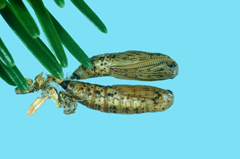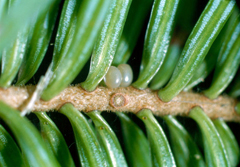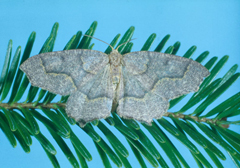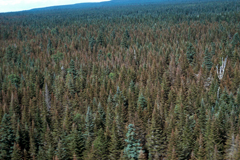Common Name
Eastern and Western Hemlock Looper
Latin Name
Lambdina fiscellaria fiscellaria and Lambdina fiscellaria lugubrosia
Order
Lepidoptera
Family
Geometridae
Main Host(s):
Eastern Hemlock Looper: Balsam fir (Abies balsamea), Hemlock (Tsuga canadensis) and occasionally Spruce (Picea), and larch (Larix).
Western Hemlock Looper: Primarily Western Hemlock (Tsuga heterophylla), Sitka Spruce (Picea sitchensis), Pacific Silver fir (Abies amabilis), Western Red Cedar (Thuja plicata) and Douglas-fir (Pseudotsuga menziesii var. glauca).
Life Cycle
The Eastern and the Western Hemlock Looper are closely related and are now recognized as a single native species by many scientists. The Eastern Hemlock Looper prefers fir as a host tree but it is also a defoliator of Spruce, Larch and occasionally deciduous trees like Maple, Birch and Poplar while the Western Hemlock Looper attacks Western Hemlock, Red Cedar, Spruce and Douglas-fir. Hemlock Looper may be found throughout Canada and in the Pacific Northwest and as far south as Georgia in the eastern US.

Like all members of the Lambdina genus, the larvae are noted for their characteristic looping form as they move, giving rise to the name ‘looper’. Loopers are often referred to as ‘inch worms’. They are rather slender in shape without bristles or hairs, and colours may vary from a mottled grey brown to yellowish green in color.
The Hemlock Looper has one generation per year and overwinters as an egg. Eggs hatch between late May and late June and the young larvae feed on the new foliage; as they mature the later instar larvae will feed on both new and old foliage. The larvae develop through four or five instars depending on the region. They pupate from mid-July to end of August. After 10 to 15 days, adults moths emerge and mate. The moths are not very strong flyers and will mate in the general area of their emergence. The female lays small greenish eggs in small clusters (less than five) in various locations including branches, the bark or even in the litter on the forest floor where they overwinter.


Impact & Damage
Hemlock Looper outbreaks rarely last more than three or four years; the infestations are noted for their rapid escalation and sudden collapse with very high levels of defoliation and associated tree mortality. The Hemlock Looper is a wasteful feeder and it will clip both new and old growth needles without eating them; this defoliation can cause tree mortality within a single season.
As the Hemlock Looper moth is not a strong flyer, it will not move long distances in search of a mate. This tends to concentrate looper populations in localized areas, resulting in very high numbers of larvae per tree. This results in extreme defoliation and high levels of impact and tree mortality.
Unlike other forest defoliators like the Spruce Budworm that eat only new foliage, the loss of both new and old foliage (due to the looper’s feeding habits) quickly weakens the tree resulting in rapid mortality. Unless intervention is planned quickly, it follows that Hemlock Looper infestations can cause significant economic and silvicultural impacts.

Resources
Learn more about Hemlock Looper
Quick Links
Contact a Valent BioSciences public health representative.
Contact Us